Canon BG-E1 Battery Grip
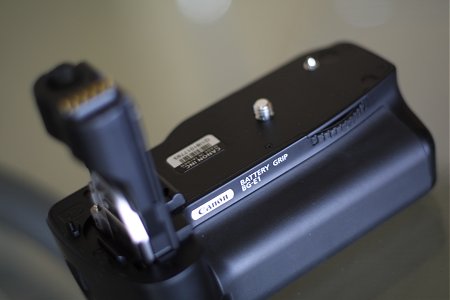
The Canon BG-E1 Vertical Battery Grip is an accessory for the Canon EOS Digital Rebel SLR camera. It serves two purposes: 1) it allows two batteries to be installed for extended shooting sessions; 2) it provides a vertical shutter release. Some people feels that there is a third purpose, which is to make the Digital Rebel much bigger for better handling or just pure ego. For me, the only purpose it serves is to provide the vertical shutter release. That is why sometimes I call it a vertical shutter grip, rather than vertical battery grip.

The other two purposes are side effects to me, not features. Why are they side effects? Because being able to carry two batteries just introduces more weight into the system. And making the camera bigger defies the original intent of creating the smallest digital SLR at the time. Nevertheless, I am extremely pleased that I now own the BG-E1 grip for the purpose I believe every camera should provide. Now I can use the Digital Rebel the way cameras are meant to be used--shutter release to the top right corner. No more monkey dances when I shoot vertical shots.
Although I had consider the size factor a side effect earlier, I do have to make the point that if you use primarily big lenses, then the BG-E1 grip will feel right at home on your camera. On the other hand, if you are still using the 18-55mm EF-S lens or the 50mm f/1.8 lens, then it will feel like you have enlarged the Digital Rebel tremendously. This has the same effect on my D30 with the BG-ED3. Luckily for me, most of my lenses are the same size or much bigger than the Digital Rebel. So the BG-E1 battery grip actually help match the Digital Rebel to the large lenses (it just feels kinda weird seeing the small Digital Rebel mounted to the end of my Canon EF 300mm f/4 L lens).
At first, I hesitated on ordering the BG-E1 grip, because it is black! The Digital Rebel body that I got is silver (the black version came out a year after its original release). I got the silver version not only because it's a little different (why does cameras have to be black?), but also because it was one to two hundred dollars cheaper. I had thought it would be strange to match a black grip to a silver body. But it occurred to me that almost all my lenses are black (not counting the white L lens and the silver 24-85mm lens that came with my IX) and I have been using them on the silver Digital Rebel just fine.
The BG-E1 grip attaches to the Digital Rebel via the tripod mount. On the bottom of the grip, there is a new tripod socket for you to mount it to a tripod. The new tripod socket is close to the lens axis, but is not right on it. The grip interfaces to the Digital Rebel body via eleven contacts in the Digital Rebel battery bay. The battery cover must be removed when the BG-E1 is attached. The BG-E1 grip has a slot for you to store the Digital Rebel battery cover.
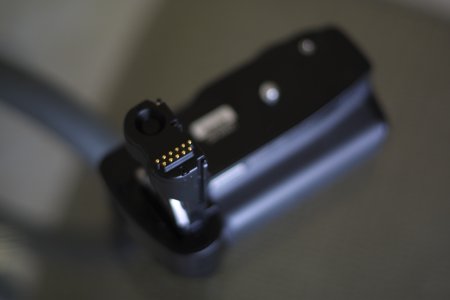
The BG-E1 grip has a smooth semi-gloss finish that is more on the matte side. The entire grip is made out of plastic with the exception of non-slip rubber on the front and back side. Overall, it's got a plastic feel much like you would find on the Digital Rebel (see my review article elsewhere). It's quite a contrast from the BG-ED3 grip on the D30, which screams solid and robustness. Although the plastic feel doesn't inspire confidence, I have no doubt it will hold up to daily use, because the Digital Rebel has held up just fine.
One huge improvement Canon made to the BG-E1 that was lacking on the BG-ED3 is the on/off switch for the grip. The on/off switch is for enabling and disabling the grip, not for turning the camera on and off. On the BG-E1 it is a big indented rotary switch. On the BG-ED3, the switch is a flip switch located on the grip handle. With the BG-ED3 switch, it is very easy to disable the switch because you touched it with your fingers (it's on the grip!) or you accidentally bumped it. I have found my BG-ED3 switch off so many times, I have to wonder if a spirit have been turning it off for me. I am almost ready to hack and disable the BG-ED3 on/off switch. The rotary switch on the BG-E1 is immuned to accidental touch or bump.
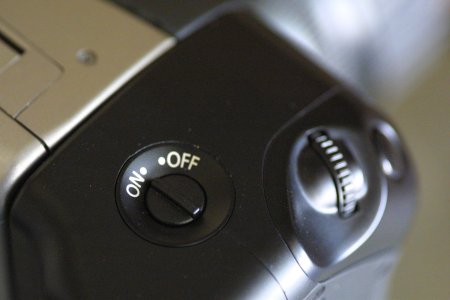
The BG-E1 also has an Av button, which replicated the Av button on the Digital Rebel body. Because this button is place very close to the other two buttons ([], AF Point), it is very easy to reach and activate. In fact, I feel it is far easy to use this button than the one of the body. I have always hated to change exposure compensation, because it requires that I take the Digital Rebel away from my face, look for the Av button, and adjust the dial while pressing the button. Now when I shoot vertical shots, I won't have to take my face away from the camera to make exposure compensation changes.
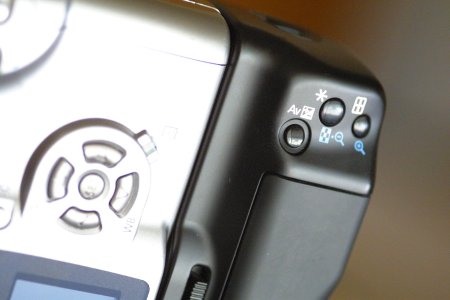
The BG-E1 battery door doesn't seem as snappy as the BG-ED3. It doesn't seem to pop out when you push the release switch. If your finger gets in the way, it is still stuck in position, so you'll have to release it again. Overall, I find the lack of spring tension a weak design. I did buy a demo version of the BG-E1, so maybe it's broken due to mishandling. You can tell us about your experience with the battery door.
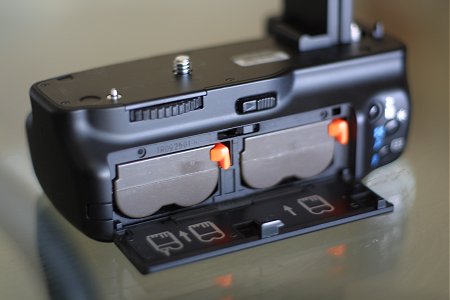
The vertical battery grips for the 20D and the Digital Rebel XT, BG-E2 and BG-E3 respectively, have a special cartridge that allows you to use regular AA batteries with the grips. I was quite disappointed that the BG-E1 grip does not have this feature. Much like the BG-ED3, the BG-E1 can only house two Canon BP-511 battery packs. If you are travelling and run out of battery, then you are out of luck until you get to a place with you can charge the proprietary battery pack. But if this grip supported the AA batteries, you can practically pick them up anywhere, in any town.
Related Links
- Canon BGE1 Battery Grip for use with the Digital Rebel Camera - Amazon User Reviews
- Canon BGE2 Battery Grip for the EOS 20D Digital SLR Camera - Amazon User Reviews
- Canon BG-E3 Battery Grip for EOS Digital Rebel XT Camera - Amazon User Reviews
- Canon BG-ED3 Battery Grip for the Canon D60, D30, EOS 10D - Amazon User Reviews
- Canon BMGE2 Battery Holder for use with the BGE2 Battery Grip - Amazon User Reviews
- Canon CPM-E3 Battery Magazine - Amazon User Reviews
- Canon GR10-L Grip Modification
$10000-above
$5000-$9999
$2000-$4999
$1000-$1999
$500-$999
$200-$499
$100-$199
$50-$99
$25-$49
$0-$24
Gift Certificate

